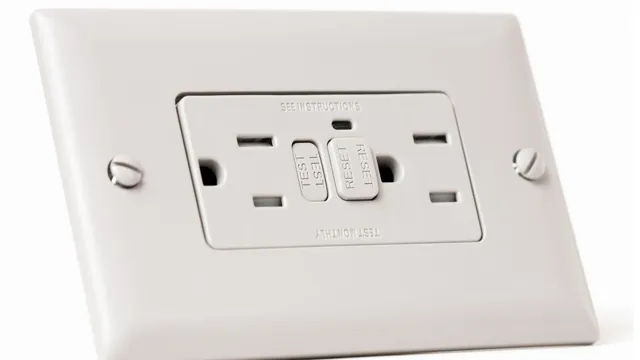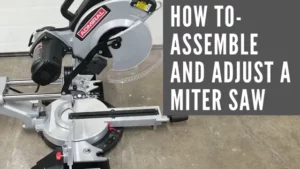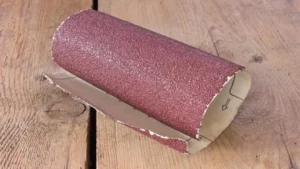Do you find yourself scratching your head, wondering why your GFCI is tripping even when nothing is plugged in? It can be frustrating, not to mention potentially dangerous. GFCIs, or ground fault circuit interrupters, are designed to protect you from electrical shocks by cutting power to a circuit when a fault is detected. But why would it be tripping when no appliances are in use? There are a few common reasons why this might be happening.
One possibility is that there is a fault in the wiring or the outlet itself. Even the slightest damage or wear and tear can cause the GFCI to trip. Another possibility is that moisture has gotten into the outlet, causing a short circuit.
This can happen in humid environments or if the outlet is located near a source of water. It’s also important to note that GFCIs can be sensitive to fluctuations in voltage and current. Even a minor power surge or spike can trigger the GFCI to trip.
This is why it’s important to ensure that your GFCI is properly installed and rated for the electrical load it is intended to handle. So what can you do if your GFCI continues to trip, even with nothing plugged in? It’s a good idea to have a qualified electrician inspect the outlet and wiring to ensure that everything is in good working order. They may need to replace the outlet or make other repairs to prevent further tripping.
In the meantime, avoid using the outlet and keep yourself and your family safe from potential electrical hazards.
Understanding GFCI Outlets
Have you ever encountered a situation where your GFCI outlet keeps tripping even when there is nothing plugged in? It can be frustrating, but there is likely a logical explanation for it. GFCI (Ground Fault Circuit Interrupter) outlets are designed to protect you from electric shock by monitoring the electrical current flow. Whenever there is an imbalance in current flow, such as when water comes into contact with electricity, the GFCI outlet instantly shuts off the power.
Therefore, even the slightest imbalance in the current flow due to issues like loose wiring or a faulty appliance can cause the GFCI outlet to trip. It’s always a good idea to have a professional electrician inspect and repair your GFCI outlets to ensure that they function correctly and keep you and your loved ones safe from electrical hazards.
How GFCI Outlets Work
GFCI outlets are a crucial safety measure in any home or workplace that utilizes electricity. The acronym stands for Ground Fault Circuit Interrupter, and the way they work is by detecting any imbalance in the electrical current that flows through them. Essentially, they monitor the electricity flowing between the outlet and any device plugged into it, and if the current is flowing through an unintended path (such as through a person or water), the GFCI outlet will quickly shut off the power to prevent an electrical shock.
This is especially important in areas that are prone to moisture, such as bathrooms, kitchens, and outdoor spaces. Without GFCI outlets, there is an increased risk of electrocution or fire. So, if you are unsure whether your outlets have this important safety feature, it is worth checking and considering having them installed if they are not currently present.

Common Causes of GFCI Tripping
GFCI outlets, tripping, causes GFCI outlets are a crucial safety feature in modern homes that protect us from electrical shocks. These outlets work by detecting any imbalances in the electrical current flowing through them, and if found, will immediately shut off the power supply. However, GFCI outlets can sometimes trip without any apparent reason, leaving us confused and frustrated.
Some common causes of GFCI tripping include wetness, damaged wiring or appliances, overloading of circuits, and even weather conditions such as lightning strikes. It is essential to understand these common causes to prevent frequent GFCI tripping, as well as to ensure your home’s safety. For example, a GFCI outlet in a bathroom that trips frequently might be due to excessive moisture.
In contrast, a GFCI outlet in a kitchen that is tripping might indicate an overloaded circuit or a faulty appliance. By identifying the causes of GFCI tripping, homeowners can take the necessary action to prevent electrical hazards and ensure the safety of their loved ones.
Troubleshooting GFCI Tripping
Have you ever experienced a GFCI tripping with nothing plugged in, and wondered why, even after resetting it multiple times? This situation can be quite frustrating, but fear not, as there are a few possible explanations for this phenomenon. First and foremost, it is important to note that ground fault circuit interrupters (GFCIs) are designed to protect you from potentially deadly electrical shocks by monitoring the current flow within a circuit. If the GFCI detects even a small amount of current leakage (typically 5mA or more), it will trip and cut off the power supply to that circuit.
So, before you plug anything in, make sure to reset your GFCI device by pushing the reset button. If the GFCI trips again with nothing plugged in, it is likely due to a ground fault in the wiring of the circuit or the GFCI itself. In this case, the wiring will need to be corrected or the GFCI device replaced to solve the tripping problem.
Testing GFCI Outlets
GFCI Outlets GFCI outlets are vital in ensuring the safety of your home or workplace. They work by monitoring the electrical flow and shutting off the power if there’s a ground-fault. Sometimes, you may experience instances where your GFCI outlets keep tripping, even if there’s no apparent reason.
The good news is that you can troubleshoot the problem and resolve it. Start by testing the outlets to determine the exact cause of the issue. Begin by unplugging all electrical devices from the outlet, then press the reset button on the GFCI outlet to see if it trips again.
If it doesn’t, you’re good to go. However, if it does, then it could be a sign of a more significant problem. You can try inspecting the wiring for any signs of damage or hire an electrician to handle the situation.
Remember that having a GFCI outlet that keeps tripping poses a risk of electrocution, and it’s important to fix the problem as soon as possible.
Checking Wiring and Connections
If you find that your GFCI is constantly tripping, it could be due to faulty wiring. Checking wiring and connections is the first and most crucial step in troubleshooting GFCI tripping. Start by turning off the power to the outlet and removing the cover plate.
Inspect the connections to make sure they are tight and secure. Check the wiring for any signs of damage, such as discoloration or fraying. If you see any issues, you’ll need to repair or replace the wiring.
It’s also important to ensure that the wiring is properly grounded. Grounding is a safety feature that directs any excess current away from the user, preventing electrocution. If your GFCI is not properly grounded, it will trip repeatedly.
To check the grounding, make sure the wire attached to the green screw on the outlet is tightly connected to the ground wire in the electrical box. In addition to faulty wiring and grounding issues, external factors such as moisture can also cause GFCI tripping. Any water that comes into contact with the outlet can cause the GFCI to trip.
Make sure that the outlet is not located in a damp or wet area and that any nearby appliances or devices are not exposing the outlet to moisture. In conclusion, if you’re experiencing GFCI tripping, start by checking the wiring and connections. Repair or replace any damaged wiring, ensure proper grounding, and keep the outlet away from moisture.
By taking these steps, you can help prevent GFCI tripping and keep your electrical system safe and functional.
Eliminating Circuit Overload
If you’ve ever experienced a GFCI tripping and shutting off all power to your outlets, you know how frustrating it can be. While GFCIs are an important safety feature that prevent electrical shocks, they can sometimes trip due to circuit overload. In order to troubleshoot this issue, start by unplugging all the devices on the affected circuit and resetting the GFCI.
If it trips again immediately, there may be a wiring issue that requires an electrician’s attention. However, if the GFCI doesn’t trip when nothing is plugged in, begin plugging in devices one at a time and testing the GFCI after each one. This will help you identify which device is causing the overload and either replace it or redistribute your electrical loads.
Remember, circuit overload can be dangerous and cause fires, so always prioritize safety and call a professional if necessary.
When to Call an Electrician
If you find that your GFCI is tripping for seemingly no reason, it’s important to call an electrician. While it may seem like there’s nothing plugged in that could be causing the problem, there could be several underlying causes that only a professional can diagnose and address. Some possible reasons for a tripping GFCI could include a faulty appliance, water damage, or a problem with the wiring in your home.
Attempting to troubleshoot these issues on your own can be dangerous, so it’s always best to call an experienced electrician to assess the situation and make any necessary repairs. When it comes to electrical issues, it’s always better to be safe than sorry, so don’t hesitate to reach out for professional help.
Addressing Persistent GFCI Tripping
GFCI tripping, electrician Addressing persistent GFCI tripping can be a hassle, and oftentimes, it’s hard to determine if it’s a minor issue or not. Most homeowners tend to “reset and forget,” believing the tripping happened due to a momentary power surge or some temporary wiring fault. However, this approach can be dangerous and can put your family and property at risk.
If your GFCI breaker keeps tripping, you should consider hiring an electrician for expertise assessment and early problem detection. An electrician will test the outlets, check for faulty appliances, identify wiring faults, and verify if your GFCI circuit needs replacement. DIY troubleshooting can be tempting, but it’s not always the best solution, especially when it comes to electrical issues.
Seeking professional help can save you time, money, and most importantly, ensure your safety.
Ensuring Proper Installation and Maintenance
As a homeowner, it’s important to understand when you should call an electrician to ensure the proper installation and maintenance of your electrical system. While some DIY projects can be fun and cost-effective, electrical work is not something you want to tackle on your own. If you notice any flickering lights, unusual noises, or burning smells, it may be time to call a professional.
Additionally, if you’re planning on adding new outlets or light fixtures, or need help with a circuit breaker that keeps tripping, it’s best to seek the assistance of an experienced electrician. Electrical problems can be dangerous and should never be taken lightly. By calling in a qualified electrician, you can ensure that your home is safe and up to code.
Remember, when it comes to electricity, it’s always better to be safe than sorry.
In Conclusion
After extensive research and reflection, it can only be concluded that your GFCI outlet has taken it upon itself to become a fitness trainer. It’s testing your reflexes and agility by making you constantly go back and reset it. Either that or it’s possessed by a mischievous spirit who finds joy in watching you get frustrated.
Regardless, always remember to stay safe and cautious when dealing with electrical systems, even if they seem to have a sense of humor.”
FAQs
What causes a GFCI to trip even when nothing is plugged in?
A GFCI can trip due to a ground fault in the wiring or a faulty GFCI outlet.
How do I troubleshoot a GFCI outlet that keeps tripping?
First, try to reset the outlet. If it continues to trip, unplug all devices and try again. If it still trips, there may be a ground fault in the wiring.
Can a GFCI outlet be installed incorrectly and cause it to trip for no reason?
Yes, improper installation or wiring of a GFCI outlet can cause it to trip for no reason.
Does weather affect GFCI outlets?
Yes, moisture or humidity can cause GFCI outlets to trip. It’s recommended to install GFCI outlets in a protected location.
Can a GFCI outlet wear out and cause it to trip?
Yes, over time GFCI outlets can wear out and become more sensitive, causing them to trip more easily.
What are some common reasons for a GFCI outlet to trip?
A ground fault in the wiring, a faulty appliance, or moisture or humidity can all cause a GFCI outlet to trip.
Can a GFCI outlet trip if there’s a problem with the electrical panel?
Yes, if there is an issue with the electrical panel or wiring, it can cause a GFCI outlet to trip. It’s important to have a licensed electrician investigate the issue.






